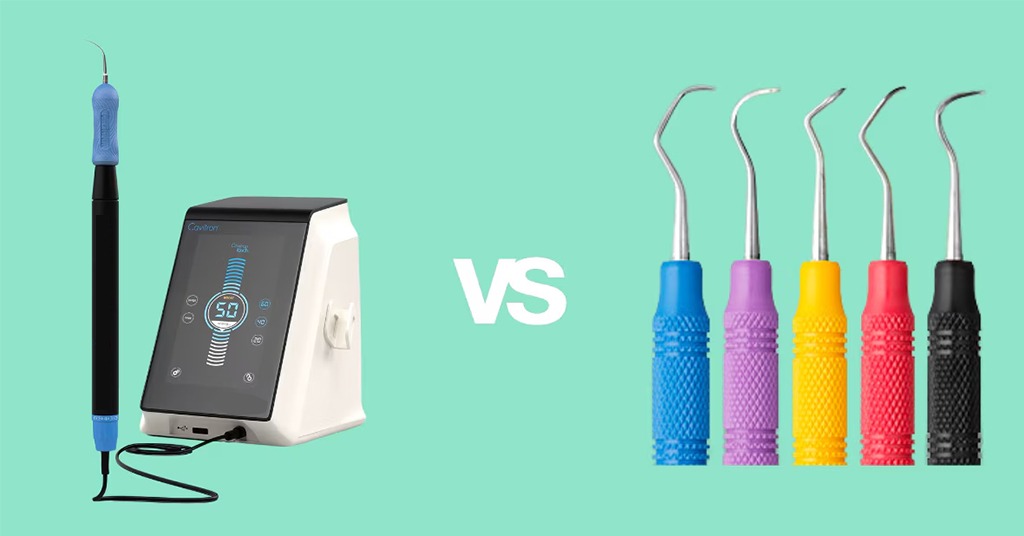Introduction
Manual vs. ultrasonic dental scalers are essential tools for removing plaque, tartar, and stains—supporting optimal oral hygiene and preventing periodontal disease. Choosing between the two depends on a clinic’s workflow, patient sensitivity, and treatment goals. At Surgment, our FDA-, CE-, and ISO-compliant scalers are engineered for precision, comfort, and long-term performance. This comprehensive guide compares both options, detailing features, applications, selection criteria, maintenance, and trends—empowering dental professionals to optimize hygiene procedures in 2025.
Why Dental Scalers Matter
Effective scaling is the backbone of preventive dental care and patient satisfaction. According to the Journal of Dental Hygiene, high-quality scalers reduce chair time by 20% and improve comfort by 15%. Substandard scalers—dull tips, weak ultrasonic vibration—can cause pain, miss calculus, or harm enamel. For example, ultrasonic scalers are excellent for rapid tartar removal, while manual scalers offer tactile control in sensitive subgingival areas. Manual and ultrasonic dental scalers from Surgment deliver high-performance outcomes in both areas.
Manual Scalers: Features and Benefits
- Design: Stainless steel with sharp, curved tips (e.g., sickle, curette).
- Applications: Best for subgingival scaling, root planing, and precision scraping.
- Benefits:
- High tactile precision.
- No need for power or complex equipment.
- Budget-friendly, with minimal maintenance beyond sharpening.
- Drawbacks:
- Slower for heavy deposits.
- Requires physical effort and training.
Ultrasonic Scalers: Features and Benefits
- Design: Handpieces with vibrating tips (20–40 kHz), using piezoelectric or magnetostrictive tech.
- Applications: Efficient for supragingival and subgingival cleaning, especially on heavy calculus.
- Benefits:
- Speeds up treatment, ideal for high-volume clinics.
- Water spray cools tissues and washes away debris.
- Ergonomic use reduces strain for clinicians.
- Drawbacks:
- Higher upfront cost.
- Can cause discomfort in sensitive patients.
- Requires maintenance and sterilization protocols.
Comparison: Manual vs. Ultrasonic Scalers
- Efficiency: Ultrasonic scalers are faster for heavy tartar; manual scalers excel in precision.
- Patient Comfort: Manual scalers are gentler for sensitive patients; ultrasonic scalers may cause vibration discomfort.
- Cost: Manual scalers have lower upfront costs; ultrasonic scalers require investment in equipment and maintenance.
- Training: Manual scaling demands advanced technique; ultrasonic scalers need training on settings and tip selection.
- Versatility: Ultrasonic scalers suit high-volume practices; manual scalers are versatile for all settings.
How to Choose Dental Scalers
- Material Quality: Stainless steel for manual; strong, autoclavable components for ultrasonic.
- Ergonomics: Lightweight and non-slip grip designs reduce clinician fatigue.
- Certifications: FDA, CE, and ISO compliance ensures reliability.
- Tip Variety: Essential for ultrasonic models—support various clinical needs.
- Warranty: Surgment’s lifetime guarantee protects your investment.
- Practice Needs: Use manual dental scalers for precision; ultrasonic dental scalers for efficiency..
Case Study: Enhancing Hygiene with Surgment’s Scalers
In 2024, a practice in Arizona replaced outdated scalers with Surgment’s FDA-compliant ultrasonic and manual models. Prior equipment caused discomfort and inefficiencies. With Surgment’s tools, the clinic reduced cleaning times by 25% and improved patient satisfaction by 18%. This transition boosted referrals and clinician morale—highlighting the value of investing in certified tools.
Maintenance Best Practices
- Manual Scalers:
- Cleaning: Rinse post-use to remove debris. Use enzymatic cleaners in an ultrasonic bath for 5–10 minutes.
- Sterilization: Autoclave at 134°C for 3–5 minutes, using sterilization pouches.
- Sharpening: Sharpen tips every 2–3 months to maintain efficiency. Use sharpening stones or professional services.
- Ultrasonic Scalers:
- Cleaning: Flush handpieces and tips with water post-use. Disinfect externally with wipes.
- Sterilization: Autoclave tips at 134°C; use chemical sterilants for handpieces if non-autoclavable.
- Inspection: Check tips for wear or reduced vibration; replace every 6–12 months.
- Storage: Store in sterile, padded trays with moisture-control packs to prevent corrosion.
Trends in Dental Scalers for 2025
- Smart Ultrasonics: Adaptive vibration for sensitive patients.
- Eco Materials: Recyclable steel and sustainable packaging.
- Ergonomic Evolution: Ultra-light, fatigue-reducing handles.
- Disposable Tips: Single-use tips to reduce infection risks in busy practices.
Frequently Asked Questions (FAQs)
- How often should I sharpen manual scalers?
- Every 2–3 months, depending on usage, to maintain precision.
- Are ultrasonic scalers safe for all patients?
- Generally yes, but adjust settings for sensitive patients or consult with their dentist.
- What’s the benefit of FDA-compliant scalers?
- They ensure safety, precision, and regulatory adherence, protecting patients and your practice.
- Can manual scalers replace ultrasonic ones?
- Manual scalers are precise but slower; ultrasonic scalers are ideal for efficiency in busy practices.
Conclusion
Whether your clinic relies on manual or ultrasonic dental scalers, using certified, ergonomic tools ensures superior outcomes and greater patient satisfaction. Surgment’s precision-crafted scalers are designed to meet the evolving needs of 2025 dental practices. Visit Surgment’s product page to explore our full range of CE- and FDA-compliant instruments.





Add comment